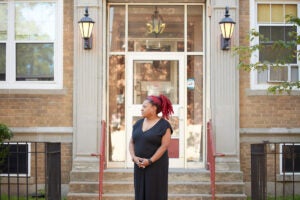
Kimberley Richardson arrived home from work one day to the Dorchester apartment she was sharing with her children. Mice had been a problem since the day they moved in, and she used to put glue traps around the apartment to catch them. “I walked in this particular day and there was a mouse eating another mouse, and I started screaming,” she remembers. “I left that apartment, and I literally never went back in.” Her mother-in-law lived around the corner, and Richardson and her children all crammed into her three-bedroom apartment. “I wasn’t really homeless, but it wasn’t my place.”
While the popular image of a person experiencing homelessness may be of someone sleeping on the street or in shelters, that’s often not the case, especially for families with children. A person might have a roof over their head the majority or even all of the time, but it may be owned by friends or family members, or an abusive partner, or be substandard and unhealthy. That was Richardson’s experience after moving to Boston from Washington state in the 1990s. Another apartment above a pizza place was infested with mice and roaches, and one of her children developed a bedwetting problem. When she told him, upset, he was too old for that, he told her he was afraid to use the bathroom because of vermin. “It’s so bad when you feel like you can’t even provide for your children,” she says. “Home is supposed to be this safe place where you are going to lay your head down peacefully, but that wasn’t the case for me.”
Most of the time when she was bouncing around different apartments, sometimes with her then-husband, and sometimes just with her children, Richardson was also holding down a job, working as an administrative assistant with the district attorney’s office and then at a trial court. But she began experiencing so much anxiety she was constantly going to the hospital with indeterminate ailments. “I was going back and forth to the emergency room all the time feeling like I was going to have a heart attack,” she says. “I was always worried with this sense of doom, and sometimes I wasn’t able to get out of bed.”
“Every town should have a place where people can go when they can’t make rent.” —Kimberley Richardson
Oftentimes the system set up to help people in her situation ended up creating additional challenges. Her husband managed to obtain a Section 8 voucher to subsidize rent for one apartment, but the landlord charged more than the voucher, so they had to pay the extra under the table. When the family qualified to be put in a shelter hotel, they were placed outside of Boston in New Bedford, creating difficulties with transportation and childcare, as well as placing added stress on one of her children who was participating in the METCO program—for low-income children to attend school in the suburbs—and had to lie and say he lived in Boston in order to continue with the program.
Richardson kept putting herself on the lottery for public housing in different communities and finally lucked out with a unit in Brookline, a suburban community just outside of Boston. “It was a miracle,” she says. Having stable housing for the first time made a big difference in putting together the other pieces of her life. She went back to school to become licensed as a social worker and now works with several clients who are themselves experiencing housing insecurity. She is also a member of Brookline Town Meeting and recently ran for a position as a commissioner for the Brookline Housing Authority. Currently, she is advocating for a town warrant article for an Office of Housing Stability where people could go who are themselves experiencing hardship. “Every town should have a place where people can go when they can’t make rent and receive assistance,” she says, “whether that’s providing money to help pay rent, so they don’t have to move, or just providing advice.”
Photo: Kent Dayton